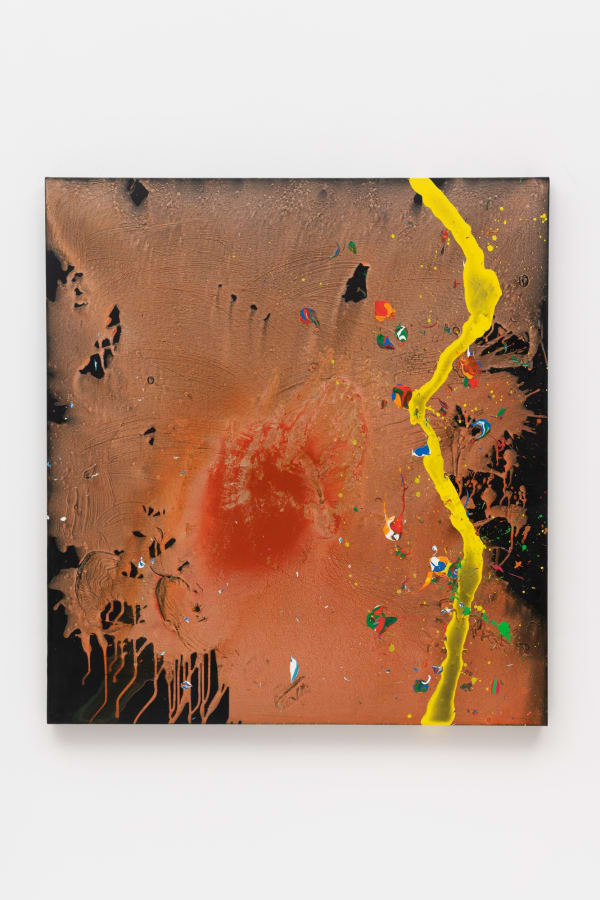Frieze London | Booth D02: John Hoyland
Hales at Frieze London 2021
John Hoyland
Booth D02, Regent’s Park, London, NW1 4NR
Wednesday, 13 October, VIP Preview (invitation only)
Thursday, 14 October, VIP Preview (invitation only & premium tickets)
Friday, 15 October, 11–7pm
Saturday, 16 October, 11–7pm
Sunday, 17 October, 11–6pm
Hales is delighted to announce its return to Frieze London for the fair’s 2021 edition, with a solo presentation of paintings by legendary British artist, John Hoyland (b.1934 Sheffield, UK – d.2011 London, UK). Focusing on the extraordinary paintings made in the final few years of his life, these definitive works are the consolidation of five decades of experimentation, and the belief in the possibilities of paint to communicate depth of feeling and emotion. Exemplary of Hoyland’s commitment to modernist tradition and modes of non-figuration, the experiential works highlight the materiality and power of paint.
‘This is not just painting about painting – it is an enquiry into the limits of human perception.’[1] Hoyland was always taking risks, striving to push the work further and in his last years he reached a new level of resolve and freedom. After the loss of many close friends and his own heart problems, he was contemplating his own mortality. Connecting to notions of the void, space and otherworldly, these magnificent works are linked to the cosmos. In the darkness there are defiant and expressive strokes of swirling bright colour and floating orbs, which bring a sense of hope and a celebration of life.
In this final body of paintings, Hoyland carefully constructs the illusion of chance. Implementing techniques he developed over a fifty-year career, of throwing, pouring, staining, and flicking paint, giving the work visceral energy. The application of paint evokes vitality and life. For these seemingly spontaneous actions, he developed a range of sophisticated automatic techniques, stating ‘with acrylic you can draw from the mist. The movements are almost balletic. You have to rehearse them.’[2] These actions are repeated, developed and work as subtle signs in each painting.
Hoyland’s use of a dark ground in these last paintings is formal, structural and emotive. Starting with black, he favoured it for its resonance and its deep contrast to the bright colours he applied after. The black gives the colour more vitality. Always in search for difference and contrast, the sections of layered, swirling bright colours draw the eye to the surface of the picture plane, creating exciting spatial interplays for the viewer.
Throughout his career, Hoyland was consistent in his painting. Art critic Matthew Collings remarks that you can always recognise a Hoyland, ‘it will always be confident and impactful; you will feel lifted just by stepping in front of it. And you will know who it is.’[3] These later works are exemplary of Hoyland’s style, but he also began to introduce references to nature. His paintings have always been about depicting the whole of life but here the natural world more visibly enters the work. A tropical and cosmic nature, one of glowing orbs of planets and stars, as well as schematic signs for birds, hint at bright feathers in motion. The celestial realms, discs of colour with pitch black centers ‘call to mind and to our contemplation its opposite, the blinding face of the sun. It is at once an image of Plutonic darkness and a sign of Apollonian light.’[4]
[1] Andrew Lambirth, John Hoyland Scatter the Devils, London: Unicorn Press, 2009, p11
[2] Andrew Lambirth, John Hoyland Scatter the Devils, London: Unicorn Press, 2009, p79
[3] Collings, M. John Hoyland: The Last Paintings, Ridinghouse: London, 2021
[4] Gooding, M. et al John Hoyland: The Last Paintings, Ridinghouse: London, 2021, p17










